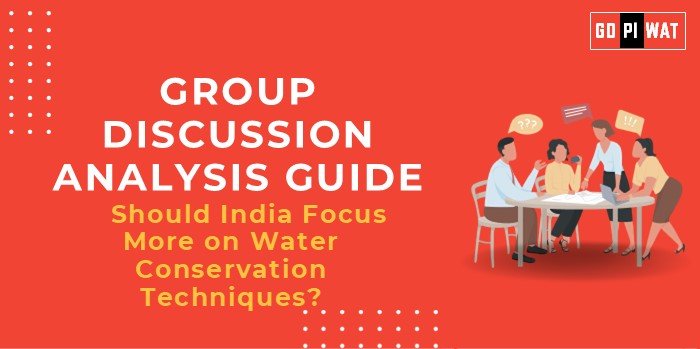📋 Group Discussion (GD) Analysis Guide
💧 Should India Focus More on Water Conservation Techniques?
🌟 Introduction to the Topic
- 🌍 Context Setting: Water scarcity is a pressing global challenge, and in India, it’s particularly acute, with 54% of the country already water-stressed. Addressing water conservation is essential for sustaining agriculture, industry, and everyday life.
- 📜 Topic Background: India receives significant rainfall during the monsoon season, yet poor storage and management lead to wastage. Increased urbanization, population growth, and climate change intensify the need for sustainable water practices.
📊 Quick Facts and Key Statistics
- 📉 Per Capita Water Availability (2024): Reduced to 1,465 cubic meters from 1,816 cubic meters in 2001, nearing water stress levels.
- 🌊 Groundwater Dependency: India is the world’s largest extractor of groundwater, with 90% used for irrigation.
- 💧 River Pollution Levels: Over 70% of surface water is contaminated, affecting 600 million people.
- 🌦️ Rainwater Harvesting Potential: Effective use could save over 200 billion liters annually.
🤝 Stakeholders and Their Roles
- 🏛️ Government Bodies: Implementing national water policies and conservation schemes like Jal Shakti Abhiyan.
- 🏗️ Industries: Adopting water-efficient technologies and reducing wastage.
- 🚜 Farmers: Shifting to sustainable irrigation methods, e.g., drip and sprinkler systems.
- 👨👩👧👦 Citizens: Practicing water-saving habits and supporting local conservation efforts.
- 🌍 NGOs/International Agencies: Promoting awareness and facilitating technology transfers.
🏆 Achievements and Challenges
Achievements:
- 🌊 Success of Jal Shakti Abhiyan: Covered 256 districts in water-stressed areas, increasing groundwater recharge.
- 💧 Adoption of Micro-Irrigation: Grew by 17% in agricultural zones between 2020 and 2024.
- 🌦️ Rainwater Harvesting: Rajasthan implemented over 2.5 million rainwater harvesting structures.
Challenges:
- 🌾 Inefficient Agriculture: Flood irrigation leads to 60% water loss.
- 🏙️ Urban Water Loss: 30% of treated water is wasted due to leaks.
- 🌍 Global Comparison: Israel utilizes 90% of treated wastewater, while India lags at under 30%.
Case Study:
- 📍 Chennai’s Water Crisis (2019): Highlighted the urgent need for integrated urban water management.
🗣️ Structured Arguments for Discussion
- ✅ Supporting Stance: “Investing in water conservation ensures sustainable growth for agriculture and urban areas, essential for India’s future.”
- ❌ Opposing Stance: “Focusing on conservation without addressing industrial waste or inefficient distribution systems is futile.”
- ⚖️ Balanced Perspective: “A combined approach involving conservation, technology adoption, and policy enforcement is crucial.”
💡 Effective Discussion Approaches
Opening Approaches:
- 📊 Statistical Impact: “With groundwater depleting at 1-2 meters annually, India is on the brink of a water crisis.”
- 🌍 Global Inspiration: “Israel’s water management offers actionable insights for India to optimize its scarce resources.”
Counter-Argument Handling:
- ✔️ Highlight the cost of inaction, citing Chennai’s water crisis.
- 💡 Present solutions like desalination and wastewater recycling.
🧠 Strategic Analysis of Strengths and Weaknesses
SWOT Analysis:
- ✔️ Strengths: Large monsoon catchment area, existing conservation initiatives.
- ❌ Weaknesses: Over-reliance on groundwater, lack of public awareness.
- 🌟 Opportunities: Integration of AI in water management, public-private partnerships.
- ⚠️ Threats: Climate unpredictability, political inertia.
📚 Connecting with B-School Applications
Real-World Applications:
- 🌿 Integrating water conservation into urban planning projects and CSR initiatives.
Sample Interview Questions:
- 🧐 “How can B-schools contribute to water sustainability projects?”
- 🌱 “Discuss water management as a strategy for mitigating climate change.”
Insights for B-School Students:
- 🌊 Opportunities for entrepreneurial ventures in water technology.
- 💸 Impact investing in conservation efforts.


